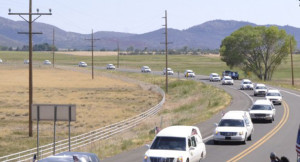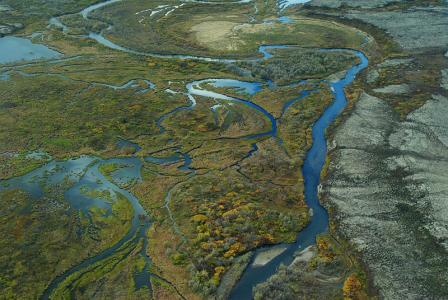Updated 11:34 p.m., Nov. 9
By John Dougherty
We’re now moving into the most dangerous phase of the presidential election.
Updated 11:34 p.m., Nov. 9
By John Dougherty
We’re now moving into the most dangerous phase of the presidential election.

Hearses carrying the bodies of Granite Mountain Hotshots pass through Peeples Valley, AZ. Photo By John DoughertyNews Analysis
News Analysis
Jasper, Alberta—Three years ago today, at 4:42 p.m., 19 members of the Granite Mountain Hotshots were killed when a fast-moving wildfire entrapped them in a box canyon at the base of the Weaver Mountains west of Yarnell, AZ.
Since that day of wildland firefighting infamy, three books have been published that have yet to answer why the men were in a location they should never have been. And now, a major Hollywood movie is in production that will ultimately completely distort what happened on that tragic afternoon. (How could you, Jeff Bridges?)
More than 22,000 comments have been posted on this site, some of which have helped piece together much of what happened on the worst day of firefighting in the history of Interagency Hotshot Crews after two state-sponsored investigations failed to provide a clear explanation.
But the ultimate “Why”, remains sealed, locked in the code of silence that permeates the world of wildland firefighting where the fear of telling the truth falls a distant third to securing a high-dollar government pension and avoid being blacklisted.
Commentary
Both state-sponsored formal investigations into the June 30, 2013 deaths of 19 Granite Mountain Hotshots failed to determine the root cause of the tragedy.
Even worse, there is now troubling evidence that the Serious Accident Investigation Report sponsored by the State Forestry Division and the Arizona Division of Occupational Safety and Health’s workplace safety investigation purposely avoided finding out what truly happen on that dreadful afternoon.
It’s possible both state investigations simply overlooked the obvious by failing to press Brendan McDonough, Granite Mountain’s sole survivor, for details about crucial radio communications between Granite Mountain superintendent Eric Marsh and the crew’s captain, Jesse Steed — but very unlikely.
If the investigators really wanted to know the gritty details of the decisions made by Granite Mountain’s leaders in the moments leading up to the monumental catastrophe, all they had to do was ask McDonough.
But according to 100 gigabytes of records, photos, videos and interviews publicly released from the two investigations, nobody ever asked McDonough what he heard over the crew’s radio in the crucial moments leading up to their deaths.
It’s not because investigators didn’t know McDonough was privy to fundamentally important information. Both investigations state that McDonough heard radio traffic between Marsh and Steed discussing their options just before the crew made an inexplicable decision to leave its safety zone.
But neither investigation bothered to ask McDonough the obvious question:
“Mr. McDonough, what did you hear Granite Mountain’s leaders say in the moments leading up to their deaths? Please provide as much detail as you can.”
There’s a good reason why the state investigators didn’t ask the key question. By failing to ask, the state of Arizona could avoid disclosing the horrific details that led up to the disaster. And those details now indicate that the Granite Mountain Hotshot’s leaders made decisions that ultimately led to the men’s deaths.
The Granite Mountain Hotshots were part of the Prescott Fire Department. But the crew was also considered a state resource through an intergovernmental agreement between Prescott and the Arizona Forestry Division. So while Granite Mountain Hotshots were employed by Prescott, the city was reimbursed by the state for their wages at rate far greater than the average pay.
The state investigations now appear to have purposely avoided pursuing a line of questioning that would have placed blame on Marsh and Steed for their decisions. Thus, the state avoided casting blame on a state resource.
Instead, the state has adopted a whitewash and wrist-slapping policy to deflect the public from the truth of what happened in Yarnell.
The whitewash was applied by the state’s Serious Accident Investigation Report released in September 2013 that concluded nobody did anything wrong.
Unnamed investigators from the Serious Accident Investigation Team interviewed McDonough on July 5, 2013, five days after McDonough’s friends and colleagues were trapped in a 2,000-degree firestorm.
The interview was cursory, at best.
Notes of the interview abruptly end after McDonough states he had the opportunity to listen to the radio traffic between Marsh and Steed just prior to the crew moving out of its safety zone near the top of the Weaver Mountains.
“I started the truck, turned on the AC and made sure the truck radios were on the right channel and turned the volume up,” McDonough told investigators.
That’s all the SAIT investigators wanted to hear – at least on the record.
The wrist slapping comes in the form of the ADOSH investigation. The work place safety investigation takes a serious swipe at the state Forestry Division for allegedly mishandling the fire by issuing three citations and levying $559,000 in fines. But in the end, all this amounts to is the state of Arizona fining itself (with $25,000 earmarked for each of the surviving families) while generating huge legal feels for the private law firm representing the Forestry Division.
ADOSH also failed to get to the root reason of why Granite Mountain was trapped by a wall of flames at the base of a box canyon filled with dried out desert brush. ADOSH investigators had two lengthy interviews with McDonough. But they too never asked the 23-year-old firefighter who was in his third year on the crew what he heard Marsh and Steed discuss.
McDonough was left alone to carry the burden of what he knew to be the true facts surrounding the worse loss ever sustained by an Interagency Hotshot Crew. It was an impossible chore. Information began to leak out into the wild fire community that McDonough heard Marsh and Steed arguing about whether to move the crew.
Rumors of the Marsh/Steed argument surfaced last June during a presentation by U.S. Forest Service official Mike Dudley to Utah wild lands firefighters. Dudley was a co-leader of the Yarnell Serious Accident Investigation Team. Dudley raised and quickly dismissed the rumor as something that couldn’t be confirmed. The only reason it couldn’t be confirmed is because Dudley’s SAIT team had failed to ask McDonough.
Last October, McDonough called former Prescott Wildlands Division chief Darrell Willis and said he needed to talk. Willis oversaw the Granite Mountain crew.
McDonough reportedly told Willis that Marsh and Steed debated over a crucial tactical decision. Marsh wanted the crew to leave its mountain top safety zone and to join him near a ranch house in the valley below by traversing through a box canyon packed with drought stricken chaparral.
Steed wanted to keep the crew in “the black” and wait out the firestorm raging below. A heated discussion ensued. Steed eventually agreed to move the crew, against his wishes. Steed, however, had the authority to turn down Marsh’s request if he believed it would put the crew at risk.
It was the penultimate moment in a wild fire tragedy of unprecedented scale.
Willis relayed McDonough’s story to the Prescott city attorney and state officials. McDonough’s bombshell disclosure remained quiet for several more months.
But records generated in the Forestry Division’s appeal of the ADOSH citations and fine tipped journalists off that McDonough had information that would fundamentally change the public’s perception of what happened on Yarnell Hill. Last week, the Prescott City Attorney told the press about the argument between Marsh and Steed.
McDonough’s story, at this point, is nothing more than hearsay. And it should in no way diminish the character of Granite Mountain’s leaders. Fighting wildfires is a dangerous business. A wrong decision can be fatal.
McDonough’s lawyer says he will testify, if legally compelled to do so.
But that day may never come.
The state has abdicated its responsibility to conduct honest and thorough investigations that discover the truth about the events that led to the deaths of 19 young men and to share the information with the public and the families of the deceased.
Instead, Arizona has cruelly shifted that terrible responsibility to McDonough.
The state’s handling of the Yarnell Hill investigations has been shameful and certainly unworthy of the ultimate sacrifice made by the Granite Mountain Hotshots.

Sensitive wetlands hosting the world’s largest sockeye salmon run flow into Bristol Bay. Credit: US Environmental Protection Agency
Guest Commentary:
By Bill Carter
Mother Nature has a way of reminding us that humility is a trait that humans too often lack. Take, for instance, the engineering firm Knight Piesold, which stated that “modern dam design technologies are based on proven scientific/engineering principles and there is no basis for asserting that they will not stand the test of time.”
Until they don’t. Earlier this month a tailings dam designed by Knight Piesold at the Mount Polley copper mine breached, dumping up to 10 million cubic meters of heavily contaminated water into surrounding streams, rivers and lakes in central British Columbia. Since the accident aerial photographs show a massive mudslide attacking the tranquil waters of a nearby salmon stream and dumping into Quesnal Lake. The salmon run will most likely perish, along with the entire ecosystem that the salmon and other species rely on for life. [Read more…]
 Vernon Masayesva, Founder and Director Black Mesa Trust
Vernon Masayesva, Founder and Director Black Mesa Trust
Western science operates by taking things apart and analyzing the pieces. This reductive process has produced enormously important technological and medical advances. Because of the scientific method, Western science appears able to control the environment and provide greater human comfort, and its successes sometimes make it appear infallible.
Native science operates by observing the whole and the interaction of the parts. This method, also an organized belief system, has sustained Native peoples and cultures for millennia against nearly overwhelming odds. But, because of this world view, traditional peoples often find themselves ill-prepared to protect their own best interest. [Read more…]